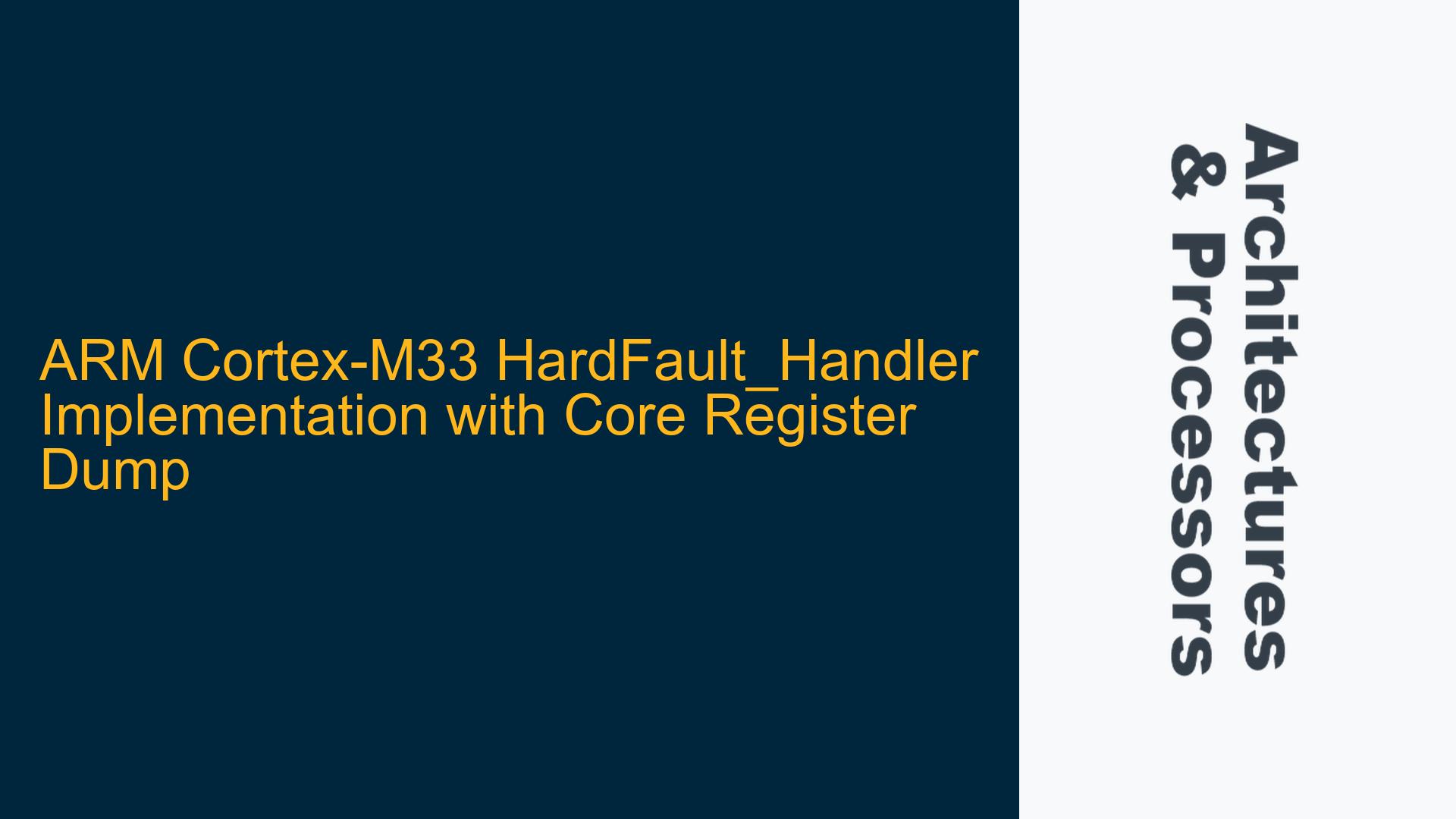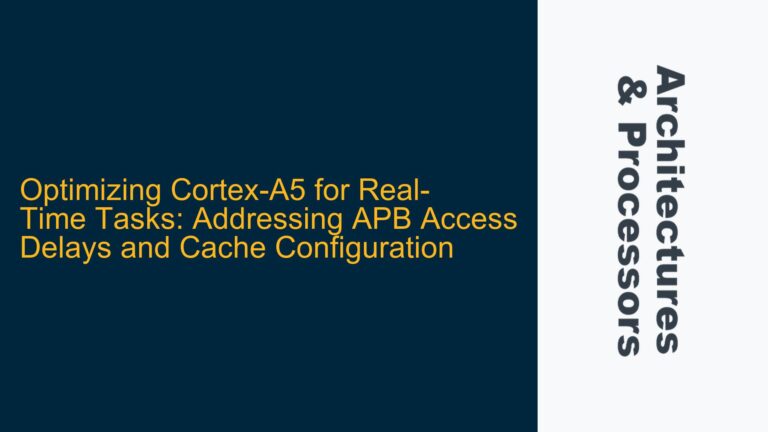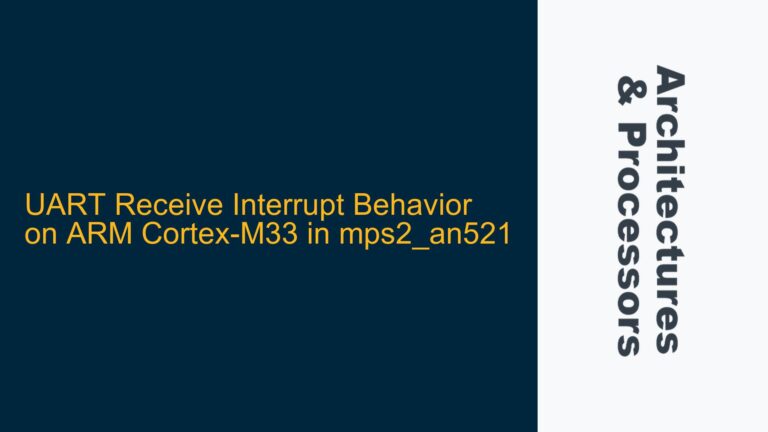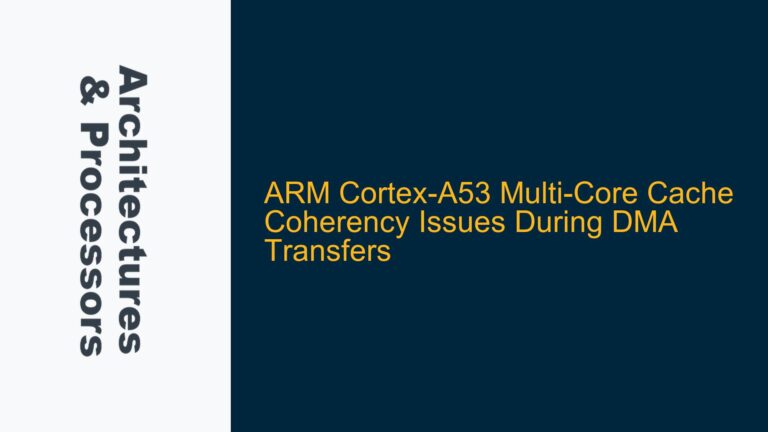ARM Cortex-M33 HardFault_Handler Implementation Challenges
The ARM Cortex-M33 processor, part of the ARMv8-M architecture, introduces several advanced features such as TrustZone security, enhanced DSP capabilities, and improved fault handling mechanisms. However, implementing a robust HardFault_Handler for the Cortex-M33 can be challenging, especially when the goal is to capture and dump core register contents during a fault. The HardFault_Handler is a critical component in embedded systems, as it allows developers to diagnose and debug unexpected system crashes or faults. The Cortex-M33’s fault handling mechanism is more complex than its predecessors (e.g., Cortex-M3/M4) due to its enhanced security features and the introduction of additional registers and stack frames.
One of the primary challenges in implementing a HardFault_Handler for the Cortex-M33 is understanding the processor’s exception handling model. When a fault occurs, the Cortex-M33 automatically pushes a stack frame onto the stack, which includes the program counter (PC), link register (LR), program status register (xPSR), and other core registers. However, the exact contents of the stack frame depend on the processor’s state (e.g., whether it was executing in Thread mode or Handler mode) and the type of fault (e.g., HardFault, MemManage, BusFault). Additionally, the Cortex-M33 introduces the Secure and Non-Secure states, which further complicate the fault handling process.
Another challenge is accessing the core registers during a fault. The Cortex-M33 does not provide direct access to the core registers in C code, as they are part of the processor’s internal state. Instead, developers must use assembly language or inline assembly to access these registers. This requires a deep understanding of the ARM architecture and the Cortex-M33’s register set, including the general-purpose registers (R0-R12), the stack pointer (SP), the link register (LR), and the program counter (PC).
Memory Stack Frame Analysis and Register Access Techniques
To implement a HardFault_Handler that captures and dumps core register contents, developers must first understand the memory stack frame that the Cortex-M33 pushes onto the stack during a fault. The stack frame contains critical information about the processor’s state at the time of the fault, including the values of the core registers. The exact layout of the stack frame depends on the processor’s state and the type of fault.
In the Cortex-M33, the stack frame is typically 8 words (32 bytes) long and includes the following registers:
- R0-R3: The first four general-purpose registers, which are used for passing arguments to functions.
- R12: An additional general-purpose register that is often used as a scratch register.
- LR: The link register, which holds the return address for function calls.
- PC: The program counter, which points to the next instruction to be executed.
- xPSR: The program status register, which contains flags for the processor’s state (e.g., Thumb state, interrupt state).
The stack frame is pushed onto the stack automatically by the processor when a fault occurs. However, accessing this stack frame in C code requires careful manipulation of the stack pointer (SP). The SP points to the top of the stack, and the stack frame is located at a specific offset from the SP. To access the stack frame, developers must first save the current value of the SP and then adjust it to point to the stack frame.
Once the stack frame is accessible, developers can use inline assembly or assembly language to extract the values of the core registers. For example, the following inline assembly code can be used to extract the value of the PC from the stack frame:
uint32_t get_pc_from_stack_frame(void) {
uint32_t pc;
__asm volatile (
"MOV %[pc], SP\n" // Move the stack pointer to a temporary register
"LDR %[pc], [%[pc], #24]\n" // Load the PC from the stack frame (offset 24)
: [pc] "=r" (pc)
:
: "memory"
);
return pc;
}
This code uses the MOV instruction to copy the value of the SP to a temporary register and then uses the LDR instruction to load the value of the PC from the stack frame. The offset of 24 is used because the PC is located at an offset of 24 bytes from the top of the stack frame.
In addition to accessing the stack frame, developers must also consider the processor’s state during the fault. The Cortex-M33 can operate in either Secure or Non-Secure state, and the stack frame may contain additional information depending on the state. For example, if the processor was in Secure state when the fault occurred, the stack frame may include additional registers related to the Secure state. Developers must account for these differences when implementing the HardFault_Handler.
Implementing a Robust HardFault_Handler with Core Register Dump
Implementing a robust HardFault_Handler for the Cortex-M33 involves several steps, including setting up the exception handler, capturing the core register contents, and storing the register dump in a dedicated section of RAM. The following steps outline the process:
-
Set Up the HardFault_Handler in the Vector Table: The first step is to configure the vector table to point to the custom HardFault_Handler. The vector table is a data structure that contains the addresses of exception handlers, including the HardFault_Handler. In most Cortex-M33 implementations, the vector table is located at the beginning of the flash memory. The HardFault_Handler can be defined as a function in C code, and its address must be placed in the appropriate entry in the vector table.
-
Capture the Core Register Contents: Once the HardFault_Handler is invoked, the next step is to capture the core register contents. This involves accessing the stack frame that was pushed onto the stack by the processor. As discussed earlier, the stack frame contains the values of the core registers at the time of the fault. Developers can use inline assembly or assembly language to extract these values from the stack frame.
-
Store the Register Dump in RAM: After capturing the core register contents, the next step is to store the register dump in a dedicated section of RAM. This allows developers to analyze the register dump later, either through a debugger or by dumping the contents to a console. The register dump can be stored in a global variable or a specific memory location that is reserved for this purpose.
-
Handle Secure and Non-Secure State Differences: The Cortex-M33’s Secure and Non-Secure states introduce additional complexity when implementing the HardFault_Handler. Developers must ensure that the handler can correctly handle faults that occur in both states. This may involve checking the processor’s state and adjusting the stack frame access accordingly.
-
Debugging and Analysis: Once the HardFault_Handler is implemented, developers can use the register dump to diagnose and debug the fault. The register dump provides valuable information about the processor’s state at the time of the fault, including the values of the core registers, the program counter, and the program status register. This information can be used to identify the root cause of the fault and implement a fix.
The following code example demonstrates a basic implementation of a HardFault_Handler for the Cortex-M33:
#include <stdint.h>
// Define a structure to hold the core register dump
typedef struct {
uint32_t r0;
uint32_t r1;
uint32_t r2;
uint32_t r3;
uint32_t r12;
uint32_t lr;
uint32_t pc;
uint32_t xpsr;
} CoreRegisterDump;
// Declare a global variable to store the register dump
CoreRegisterDump registerDump;
// HardFault_Handler implementation
void HardFault_Handler(void) {
// Capture the core register contents from the stack frame
__asm volatile (
"TST LR, #4\n" // Check the EXC_RETURN value to determine the stack frame
"ITE EQ\n" // If-Then-Else instruction
"MRSEQ %[r0], MSP\n" // If using MSP, move MSP to r0
"MRSNE %[r0], PSP\n" // Else, move PSP to r0
"LDR %[r1], [%[r0], #0\n" // Load R0 from the stack frame
"LDR %[r2], [%[r0], #4\n" // Load R1 from the stack frame
"LDR %[r3], [%[r0], #8\n" // Load R2 from the stack frame
"LDR %[r4], [%[r0], #12\n" // Load R3 from the stack frame
"LDR %[r5], [%[r0], #16\n" // Load R12 from the stack frame
"LDR %[r6], [%[r0], #20\n" // Load LR from the stack frame
"LDR %[r7], [%[r0], #24\n" // Load PC from the stack frame
"LDR %[r8], [%[r0], #28\n" // Load xPSR from the stack frame
: [r0] "=r" (registerDump.r0),
[r1] "=r" (registerDump.r1),
[r2] "=r" (registerDump.r2),
[r3] "=r" (registerDump.r3),
[r4] "=r" (registerDump.r12),
[r5] "=r" (registerDump.lr),
[r6] "=r" (registerDump.pc),
[r7] "=r" (registerDump.xpsr)
:
: "memory"
);
// Store the register dump in a dedicated section of RAM
// (Implementation depends on the specific memory layout of the system)
// Infinite loop to prevent further execution
while (1) {
// Optionally, trigger a breakpoint or log the fault information
}
}
This code defines a structure CoreRegisterDump to hold the core register contents and implements a HardFault_Handler function that captures the register contents from the stack frame. The handler uses inline assembly to access the stack frame and extract the values of the core registers. The register dump is then stored in a global variable registerDump, which can be analyzed later.
In conclusion, implementing a HardFault_Handler for the ARM Cortex-M33 requires a deep understanding of the processor’s exception handling model, memory stack frame layout, and register access techniques. By following the steps outlined above and using the provided code example, developers can create a robust HardFault_Handler that captures and dumps core register contents, enabling effective debugging and fault diagnosis in embedded systems.






